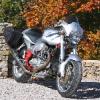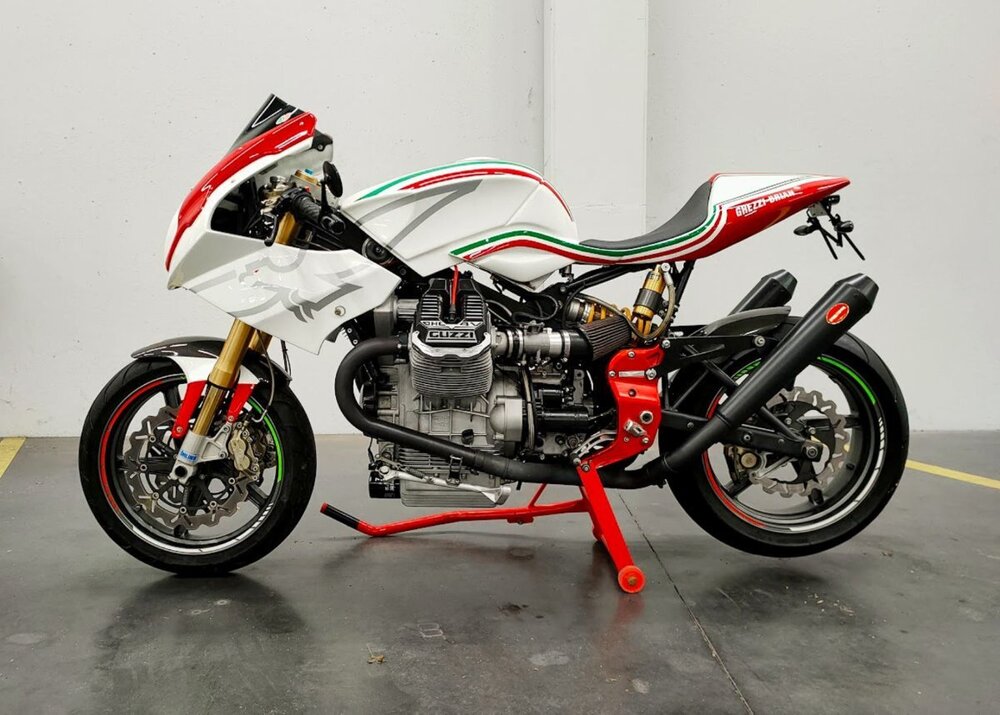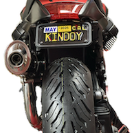Leaderboard
Popular Content
Showing content with the highest reputation on 01/10/2024 in all areas
-
First thing after I bought and driven my Nevada was to check for any ads for big blocks near me. Second thing was to check forums for known issues. So even if this is my first communication with good people on guzzi forums, I was reading and looking for all info maybe for 3 years now.4 points
-
That was a bit cruel. Posting that without a safety warning for eye trauma! And in case anyone is wondering I was neither drunk, nor have I had a stroke. I always look like that......4 points
-
First priority: get the right springs. More preload will not solve that. I had to learn this "the hard way" . . .3 points
-
3 points
-
Springs can loose their "spring". It does happen. But it would be unusual for it to happen on a motorcycle spring. It tends to happen, for example, on Jeep JK's, which use coil springs, if your springs are low quality and not properly heat treated. That, combined with the heavy nature of a Jeep, can result in the springs sagging. But I doubt the stock V11 spring would be prone to that. More likely what might feel like the springs being worn out is the shocks being worn out. The shocks are there to control the springs. That said, the stock spring is not always the right rate for the rider depending on the riders weight and riding style. Preload does not, as mentioned, change spring rate. Preload sets ride height when you are on the bike riding down the road. Adding preload will make the bike ride higher when you are on it riding down the road. That can be a good thing, but it won't make a spring that is too soft stiffer if you add preload. This has been covered repeatedly on here, but a standard path forward is to fully set sag. Setting sag will tell you if your springs are too soft, too hard, or right. If the sag of the bike is right with you on the bike (Race Sag is the term used for that), but the bike sags too much under just its own weight the springs are too stiff. If the Race Sag is right but the bike sags too little under just its own weight the springs are too soft (that means you had to add too much preload into the spring to get the Race Sag right, so sag under just the weight of the bike was reduced). Yes, it can sound backwards. If Race Sag is right and the bike sags the right amount under just the weight of the bike your spring rate is good. From there you can go about adjusting dampening to get the ride quality you are looking for. Harsh ride over jolts can be a lack of spring rate, but it can also be a lack of dampening. Set your sag first, and if required change your springs so sag is right. Then adjust dampening. A longer rear shock usually means higher ride height at the rear. But, as mentioned, it does not always mean that. The spring rate and preload do play a role. But with most longer rear shocks you are increasing the ride height at the rear.2 points
-
With the 5.5 mm longer shock on my ShortFrame Sport, the forks are raised 5mm. With my spring selections and "sags" (30% front/25% rear), I found this all a sweet spot. As @GuzziMoto said, more fork raise was not better (for my set-up)......2 points
-
Both dropping the forks and a longer shock are common mods for the V11. But usually it is one or the other. That said, there is nothing that says you can't do both. But just because some is good doesn't always mean more is better. Both dropping the front forks and a longer rear shock reduce trail. Trail is a big part of what make the motorcycle stable. Too little trail can lead to stability issues. So, there is a point where more is not better, at least when it comes to this. That is one reason why I prefer an adjustable length shock to a fixed length longer shock. But if the shock length is fixed you can always use the fork height adjustment and the preload adjustment to get the steering where you want it.2 points
-
To add to Pete's reply, here is the skinny on those throttle bodies from Pete himself. Very informative... When I was looking for a carc bike, it was surprising how some of the owners didn't have a clue about this. Also check on swing arm bearing service. Again, some owners didn't know how they came under lubricated when new. If service was never done, it is better if the bike has low mileage and not seen much moisture, IMO. Both my CARCs had under 7k, so I i wasn't too worried. This winter I will do the deed. Also make sure the engine has roller tappets and not flat. 2012 was the cutoff serial numbers, but as Pete has poi ted out before, this needs to be inspected for positive confirmation and not rely on just serial numbers. Lots of info on these three items in search.2 points
-
What a beautiful day to ride…blue skies, cold and crisp, little traffic, very few motorcycles out today…fair weather riders…probably too cold! Several layers, balaclava and good gloves makes the riding very enjoyable. Good music in the helmet…just perfect! 140 miles on the Scura through the forest…halfway thru stopped for a Peppermint Latte to warm up! Still feels like the holidays! Scura runs like a champ!!2 points
-
Yes. As I understand it, if you dial in too much preload, your suspension will top out when the wheel "falls into a hole". If you have to dial in that much preload to get the ride height to where it should be, your springs are too soft for the weight to be carried. If the springs are too soft, they will bottom out regardless of what you do with the preload.1 point
-
No. Preload can help to get the ride height right, as long as the springs have approximately the right rate. If you are bottoming out regularly, the spring rate is perhaps too soft, or the springs have maybe lost something due to age. Having said that, I'm nor exactly a suspension Guru, but I believe that is correct.1 point
-
Shock length... a thread of landmines the likes of tires and oil. The difference between a long and a short shock where the ride height is identical, is zero until you find the circumstance in which the longer shock can extend further than the shorter shock. (or bottom out, but that's dirt stuff) The shorthand of this is that on-road, the only time you'll see a difference is when you're turning on the brakes, hard. A longer shock allows the rear to rise further before the weight of the rear wheel comes into play, which in turn reduces rake and generally eases turn-in.1 point
-
1 point
-
I think when you say "forks are raised 5mm" you mean the triple clamps are slid down the fork tubes 5mm, so that the front end is 5mm lower, right? When you say "raised" you mean the fork tubes relative to the triple clamps, I think. 10mm - 15mm is a common amount to lower the front end, but raising the rear end means less lowering of the front end would be required to achieve the same result. 10mm higher at the back along with 5mm lower at the front is roughly the same as 15mm lower at the front as far as steering goes, while not costing you the ground clearance that only lowering the front 15mm would have cost. Back when I raced a HD 883 we ran way longer shocks in back AND lowered the front to try to get the bike to turn faster. But you were flirting with the limits of not having enough trail. Stability was often an issue.1 point
-
Bonzo and Moon . Out of control and in control at the same time1 point
-
That girl is a FOX , but that paint job on that bike is righteous .1 point
-
This is all really useful stuff, the ride height and the effects of different shock lengths to rider experience. Also peopel oftne drop the front forks in the triple clamps by 2 - 3mm to sharpen up the steering. I wonder how the combination of the two work together to get a happy set up?1 point
-
@docc said Docc, you sent me into a rabbit hole of alternative guitar tuning. Way back when I used to work on songs using them, I referred to everything not standard guitar tuning as open. Technically I was incorrect, but it's not really an argument of significance for me. I found the various tunings fascinating, and so many, like Makana, produce such a great sound. I gave up years ago on most of it because the memory work with standard tune was more than enough for me. My 'Going to California' example used double drop d, which is at least part of the slack tuning Makala is using for that song. Curiosity demands I figure it out fully. On his website they describe slack as a unique to Hawaii traditional style. He is quite talented.1 point
-
Do lots of research on the CARC models. Once sorted they are pretty much bulletproof but they do have a couple of Achilles heels you need to be aware of. Pay particular attention to the throttlebodies before you make your purchase and learn what to look out for that will give the game away is they have been messed around with.1 point
-
YAH He and Keith Richards both turned 80 yesterday I believe....deep sigh...lol Bonham really WAS the Shit!1 point
-
She wasn't called Alice, was she? The one you were living next door to...1 point
-
Plates should be ready this Friday but we are expecting some solid snow here in Seattle at the end of this week, so I will have to see how the roads are that day. Will keep you all posted.1 point
-
Bingo. The shock length certainly affects ride height. So does the spring rate and corresponding preload of the spring, which sets sag. There is not one single factor that determines seat height. All the various factors contribute. You can change one factor, like a shorter or longer shock, and if everything else stays the same the change in ride height should be predictable. But often changes like a new shock that is longer or shorter accompany other changes like a new spring that is stiffer or softer and different preload to get a different sag amount. It is possible to run a longer shock (5mm longer) and simply have 10mm more sag because you are running a different spring and preload combination resulting in the same seat height you had with the shorter shock. That said, the generally positive improvements of running a longer shock, quicker steering, won't really be delivered if you don't also have a corresponding increase in rear ride height with the longer shock combination you switch to.Running a longer shock without the small increase in rear ride height it tends to deliver won't deliver the improvements in steering that a longer shock can. But you can get similar improvements without a longer shock simply by running a spring / preload combination that increase rear ride height by 10mm or so. It is a more complete improvement if you run the longer shock with the correct spring / preload combination. But a similar improvement can be achieved by swapping out the spring and setting preload to get the desired increase in rear ride height.1 point
-
1 point
-
True, that, brother. I made other, sketchy, mistakes with my failed lift. Chief among them: placing the sump jack at the forward edge of the sump to better lift the front. Bad idea! (as it turned out) (it slipped out) and lifted the rear support sideways. Already half-way to a bad day . . .0 points














